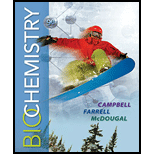
Concept explainers
RECALL Briefly summarize the steps in the electron transport chain from NADH to oxygen.
Interpretation:
The steps of the electron transport chain from
Concept introduction:
Electron transport chain is the series of electron transfer from electron donor to electron acceptor; it is a redox reaction.
It is the last component of aerobic respiration and is the only reaction that utilizes atmospheric oxygen.
Answer to Problem 1RE
Solution: Following are the steps of the electron transport chain from
Explanation of Solution
First the electrons from
Oxygen is the last electron acceptor that accepts electrons from cytochrome
Want to see more full solutions like this?
Chapter 20 Solutions
Biochemistry
- RECALL Suggest a way in which the difference between the functions of hemoglobin and myoglobin is reflected in the shapes of their respective oxygen-binding curves.arrow_forwardRECALL Define substrate-level phosphorylation and give an example from the reactions discussed in this chapter.arrow_forwardREFLECT AND APPLY Argue logically that the urea cycle should not have evolved. Then, logically counter your argument.arrow_forward
- REFLECT AND APPLY Why is it useful to plot rate data for enzymatic reactions as a straight line rather than as a curve?arrow_forwardRECALL Define the term reducing sugar.arrow_forwardREFLECT AND APPLY List two classes of compounds derived from arachidonic acid. Suggest some reasons for the amount of biomedical research devoted to these compounds.arrow_forward
- RECALL What is qPCR?arrow_forwardREFLECT AND APPLY Explain how the pentose phosphate path- way can respond to a cells need for ATP, NADPH, and ribose-5- phosphate.arrow_forwardREFLECT AND APPLY Outline the methods you would use to pro- duce human growth hormone (a substance used in the treatment of dwarfism) in bacteria.arrow_forward
 BiochemistryBiochemistryISBN:9781305961135Author:Mary K. Campbell, Shawn O. Farrell, Owen M. McDougalPublisher:Cengage Learning
BiochemistryBiochemistryISBN:9781305961135Author:Mary K. Campbell, Shawn O. Farrell, Owen M. McDougalPublisher:Cengage Learning
